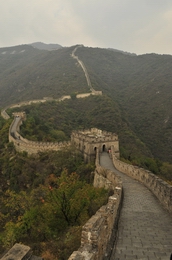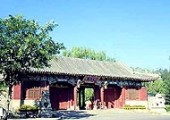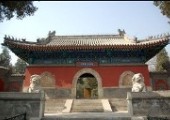Great Wall Culture

According to legend, the Great Wall was built by the first emperor of the Qin Dynasty, Qin Shi Huang (Reigned 221-210 BC), though historical records trace the true origin of the wall to defensive fortifications built in the fifth century BC From the statement "Square walls surround the Kingdom of Chu", we can trace walls with a total length of 500 kilometers in what is now Henan Province dating back to the Eastern Zhou Dynasty (770-256 BC). In addition to Chu, the kingdoms of Qin, Qi, Wei, Zhao, Han and Yan all had their own separate defensive walls spread about through the Yellow and Yangtze River basins, running in different directions and beginning and ending abruptly. The walls of this period bear little relationship to the wall of today with its predominantly east-west configuration.
In 221 BC, the armies of Qin conquered the abovementioned six kingdoms and unified China. Qin Shi Huang ordered the demolition of the walls separating these kingdoms and rebuilt a new "Great Wall", based on the walls protecting the northern frontiers of Yan, Zhao and Qin. According to the Records of the Historian (shiji), written approximately 100 BC, General Meng Tian mobilized 300,000 laborers and built a great wall which followed the contour of the land, taking advantage of natural defenses". This wall extended more than 6,000 kilometers from Lintiao (in Gansu Province) to Liaodong. Thus the general plan of today's Great Wall was laid down during the Qin Dynasty (221-206 BC).
During the Han Dynasty (206 BC-AD 220) Which followed the Qin, in addition to making improvements in the Qin wall, the Han emperors constructed a separate outer wall north of the Yinshan Range with a total length of 10,000 kilometers. This was the longest single wall built in ancient China. After the fall of the Han Dynasty, the wall gradually decayed into ruins. In 1368, the founding year of the Ming Dynasty, Emperor Taizu commanded his general Xu Da to direct the reconstruction of the Great Wall. Beginning at the Juyong Pass, the work went on for more than 100 years. Based on the general dimensions of the Qin Wall, the Ming wall stretched from its westernmost point at the Jiayu Pass more than 6,000 kilometers east to the Yalu River. The section, which lies between the Jiayu and Shanhai, passes remains in good condition today and is known throughout the world as the Great Wall of China.
Different sections of Great Wall
Badaling Great Wall Mutianyu Great Wall
Huangyaguan Great Wall Jinshanling Great Wall
Simatai Great Wall Juyongguan Great Wall
Jiayuguan Great Wall Overhanging Great Wall
Gubeikou Great Wall
History of the Great Wall Marathon
1999 2000 2001 2002 2003 2004 2005 2006 2007 2008 2009 2010 2011
Great Wall Marathon + China tour packages
5 days - Great Wall Marathon + Beijing tours
11 days - Great Wall Marathon and Classic China tour
12 days - Great Wall Marathon with Yangtze Cruise
16 days - Great Wall Marathon with Tibet Tour




